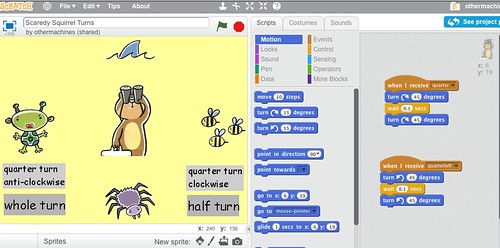Sometimes I can spend hours searching TES and other web sites for the right interactive teaching resource. This week I was teaching direction, quarter and half turns to Year 2 and I wanted something I could use on the interactive whiteboard and that the children could use – but nothing seemed quite right. Some lacked targets, some used degrees to describe the turns – so I decided to have a go at making my own.
I used Scratch to make a very simple, but very effective, resource. We’ve been looking at Mélanie Watt‘s Scaredy Squirrel books in literacy and art this week for World Book week, so I used this as my theme.
I stuck pictures of 4 of the things Scaredy is frightened of on 4 walls of the classroom and we practiced making turns as a class before doing differentiated worksheets answering questions about quarter and half turns, using the same targets in the same arrangement.
The next day I put the Scratch project up on the whiteboard and as a class we checked the answers to the questions. I’d ask “if Scaredy turned a quarter turn, what would he see?” – children would talk to their partners, and then I picked one to come and check their answer by clicking on the buttons.
Very simple, but it worked really well and only took me about 20 minutes to make (I already had the pictures scanned in) – less time than I’d spent scouring the internet for the right tool to teach what I wanted, and this was customised to match our literacy theme.
Click the green flag in the middle of the screen to start – won’t work on iOS devices, alas.
The code is here if you want to see how it’s made: http://scratch.mit.edu/projects/18846330/. The advantage of uploading the code to the Scratch web site is that you get a Flash version of the game so you can use it on classroom computers that don’t have the Scratch software installed.
The buttons are sprites which broadcast messages when clicked. Scaredy’s sprite has different blocks of code telling him how far to turn, and in which direction, when different buttons are pressed. I also made Scaredy turn in 45 degree steps so the children could see more clearly which way he was rotating.
I can think of several ways to extend this: the other creatures react when Scaredy looks at them; making a game where the child guides Scaredy back to his nut tree by giving him directions; and, of course, getting the children themselves to remix the game in Scratch.

